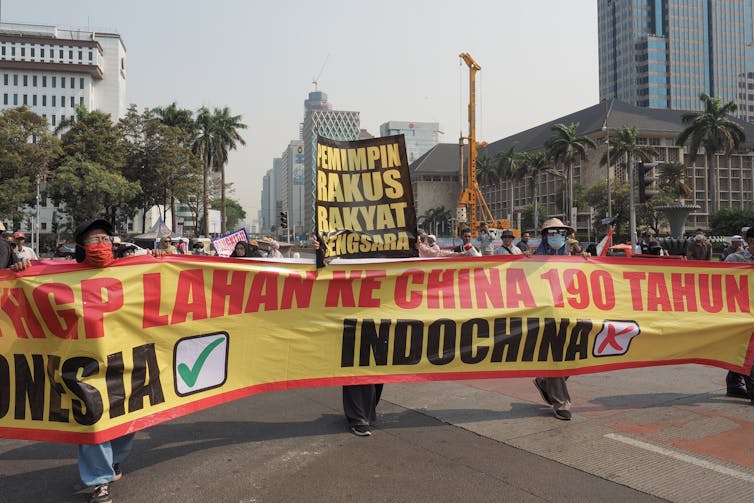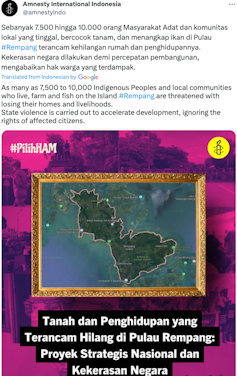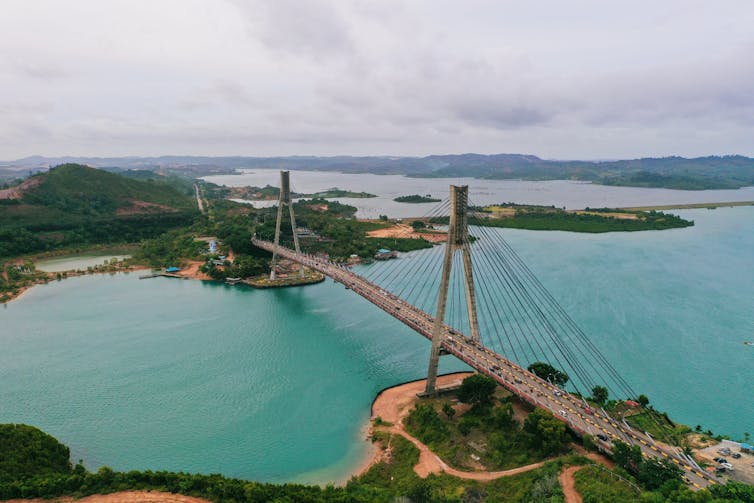I first visited Rempang island in Summer 2022. Greeting me were lush fields lined with coconut and banana trees, picture-book fishing villages with houses jutting into the water on stilts, and boats carrying people between the dozens of islands that dot the Riau archipelago in western Indonesia. I had made the pleasant, one-hour ferry trip from bustling, glass-and-chrome Singapore. This felt like another world.
My hosts (an environmental lawyer and an indigenous Melayu community organiser) and I had reached Rempang from the economic hub of Riau Islands province: the special manufacturing, trade and logistics zone of Batam. We had gone from Batam to Rempang by crossing one of the six metal bridges that connect the islands of Batam, Rempang and Galang. This network of bridges has turned the islands into an economic zone, now called the Barelang region.
My ongoing research is investigating how the international quest for green energy is reliant on “sacrificial zones” in developing countries. The transition to green energy, far from creating a green new deal for all, is actually reinforcing entrenched inequalities and hierarchies.
Shutterstock/NPCplastik
I became interested in Rempang when I saw news reports heralding a renewable energy revolution. Companies from Singapore, Portugal and beyond were signing agreements to build vast floating solar farms in local reservoirs in the Batam region. The plan was that the clean energy produced would be transported from the sunlit western Indonesian islands of Batam, Bulan, and Rempang to energy intensive Singapore via undersea cable.
But on reaching the islands, and visiting the sites named in the news reports, I saw no sign of green energy activity. The waters were placid. There was no solar farm in sight. I shrugged, met friends, ate the freshest possible seafood at a small Kelong restaurant that was half on land and half in the sea, and went back to Singapore on the ferry.
‘A state-backed land grab’
My return a year later could not have been more different. The atmosphere was tense and the roads were lined with armed police. Large military trucks moved ominously on the tar, monitoring the situation. Villagers stood around in clusters, anxious and clutching at straws of information trickling through on WhatsApp and word of mouth about what seemed to be a state-backed land grab.

This article is part of Conversation Insights
The Insights team generates long-form journalism derived from interdisciplinary research. The team is working with academics from different backgrounds who have been engaged in projects aimed at tackling societal and scientific challenges.
People were protesting because the 16 villages and 7,500 inhabitants of Rempang are facing eviction, as plans to transform their home into the latest hub for the global green transition gather apace. The Indonesian government and a Chinese-backed business consortium want to move the entire community to another island and turn their home into a huge solar panel manufacturing centre, solar farm, and “ecocity”.
Videos filmed by residents from sites of protest show armed military and police clashing with the farmers and fishers of Rempang. The videos, some of which have been posted on social media, show people being thrown to the ground, bleeding, apparently roughed up by state forces. There have been many arrests. I regularly hear from friends and acquaintances who tell me that police and government authorities have taken to summoning suspected protestors, examining their phones for incriminating evidence, and looking into their home, work lives and tax affairs. Residents are clear this is “harassment” and “pressure” to give up their land and withdraw from the struggle.
Alongside large and publicised confrontations, the residents of Rempang are resisting the everyday encroachments of the proposed project. In local, spontaneous opposition in affected villages, women, including mothers and grandmothers in veils, have blocked roads, preventing government officials from entering villages to measure their land. Videos show them wailing as armed police approach. In others, young girls and old women can be seen in a semi-conscious state, being taken to hospital after apparent tear gassing.
But how did things move so fast? From April 2023, news had begun to filter in that a well-connected businessman from Jakarta, who reportedly made his money and reputation through businesses operated on behalf of the Indonesian military, before turning to banking and real estate, was to build a “township” on Rempang.
By August, the better informed in the community had gathered that the planned Rempang project was to be a collaboration between Tomy Winata’s Artha Graha Group, and a Chinese “glass manufacturer”. By September, Winata himself was granting interviews and talking about his plans for an ecocity. The project – which has the enthusiastic blessings of the Batam economic zone authorities, the provincial government of Riau Islands, and importantly, the central government in Jakarta – is imminent.
It will displace 16 villages on Rempang island and will cover a mind boggling 17,000 hectares (one square hectare is roughly equivalent to one rugby field). As residents discussed these figures among themselves, they lobbed questions at me: “Why do they need so much land?” and “what will they even do with it?”
An elderly, mild mannered fisherman I spoke to in August, who was trying to organise resistance to what was then still a mysterious investment pushed by Jakarta and China said he was worried about the community being relocated:
People here have history. Their whole story is in this area. They love this land. They live here. You can make your project here. Welcome. But build it in an empty area. Whatever you do, don’t disturb us. Keep us here, give jobs to our children … When people ask me, where is your village, I say it is Bapke [pseudonym]. Later, what will I say? Our identity will be lost.
From trickles of information to violence
On first learning about the Rempang project, residents petitioned different layers of government, sought meetings, and even went to Jakarta to try and meet officials. Finding them unresponsive, people contemplated taking to the streets.
By mid-August, groups were meeting at local cafes and in the homes of community leaders. They were determined not to give up their land. One member of a group that was congregating in Batam told me “there is a meeting of Melayu youth to plan a protest at Barelang [bridge], and at the mayor’s office [in Batam]. We are here to discuss the situation. We will protest in the coming days”.
By the last week of August, there were demonstrations organised by the community at various locations in Rempang and Batam, and by civil society organisations in Jakarta. Soon, my contacts were talking about “clashes between the community and BP Batam” (the authority in charge of the Batam free trade zone), and larger and larger demonstrations involving not just Rempang residents, but ethnic Melayus from the surrounding islands as well. At these early protests, police forces were present, there was tension, but no violence.
Despite growing opposition, authorities dismissed popular discontent as “miscommunication”. As reported in the press, increasingly incensed residents began to resort to violence, using rocks and glass bottles. These were desperate measures from increasingly desperate people facing the might of the state.

Shutterstock/KevinHerbian
Local and international media, which had initially ignored the Rempang issue, was finally covering it amid escalating “rioting” at Rempang.
A Melayu youth messaged me on Whatsapp recently, saying: “I was called to the police station for questioning … I went through the investigation process [for many hours] regarding the case at [location X]. There was a clash between community and authorities which resulted in eight people being sent to prison.”
Ecocity and mega solar panel production facility
Meanwhile, preparations for the Rempang development have continued apace. It appears that as early as 2004, the Indonesian company PT Makmur Elok Graha (PT MEG), which is part of the Artha Graha Group, secured permission from the Batam Regional People’s Representative Council to develop Rempang. The understanding at the time was for a tourism zone, covering 5,000 hectares. Existing villages were to be preserved in this plan.

X
Nothing came of the agreement with PT MEG, until 2023. Earlier in 2023, representatives of PT MEG visited houses of notable locals in Rempang and indicated their intention to survey the land. According to one such local businessperson and community leader, the company did not inform him about what they intended to build. However, in a neighbouring village, some people say they were told about a survey for a glass factory, and in yet another, there was apparently talk of a hotel.
Now, in October 2023, the official business and government plans have revealed a much larger development than was suggested in 2004. The “Rempang ecocity” will be an industrial, service, and tourism area, as envisioned in the National Strategic Programme (PSN) of 2023. It is a joint venture between BP Batam (which incorporates the free trade zone and Free Port Management Agency) and PT MEG. The project aims to attract investment of about 381 trillion Indonesian Rupiah (Rp) by 2080, creating jobs for 30,000 workers. This equates to around US$24.8 billion or £20 billion.
Crucially, there is a major international investor: the world’s largest manufacturer of glass and solar panels, China’s Xinyi Glass. And the “glass factory” is no ordinary enterprise. It is a mega-investment from Xinyi which has reportedly pledged US$11.6 billion for the factory over several decades. In return, it seems, they have been promised Rempang’s land.
In my previous research I called a similar zone of special economic interest in India, “hydra-like”. That’s because these sought after zones change shape, name and purpose according to what’s profitable at a particular point in time. And what’s profitable in Indonesia, and the world today, is the transition to green energy. Therefore, the showpiece of the Rempang ecocity proposal is the mega solar panel manufacturing facility that will probably supply the world with solar panels in the near future.
In the existing vision of the ecocity, there will be several zones for industries, commercial and residential purposes, tourism, solar farms, and wildlife and nature. Rempang currently sustains farmers, fishers, seaweed processors and exporters, traders and shopkeepers, seafood kelongs, ten primary schools, three junior high schools, a senior school, hospitals, tourist guest houses and more. But it seems there is no place for this community in the futuristic vision of “green” Rempang.
A project of strategic importance
The proposed solar panel manufacturing facility, and the Rempang ecocity, may be a portent of a globalised production boom that the government of Indonesia, and its partner countries like China, envision for this region. This economic vision intends to draw on Indonesia’s young and cheap labour, its land and natural resources like silica, nickel and cobalt, and its willingness for regulatory flexibility.
It is this flexibility that made the government declare the proposed Rempang ecocity as a Project of National Strategic Importance, allowing it to bypass social and environmental impact assessments, and acquire land quickly.
The strategic importance of the Rempang project has not been lost on my contacts in Rempang. One of them speculated that the government’s plans to build a new capital city on Borneo could be a motive for closer relations with China. They wondered whether the money for the new capital Nusantara would come from China, and whether that was why their land in Rempang had been “gifted” to the Chinese.
Another said: “Did they ask us? No. They only value investment. Not people.” Still others draw links with China’s Belt and Road Initiative, which has invested heavily in Indonesian infrastructure.
Not far from Rempang is one such investment: the series of bridges that will connect two of the largest islands in Riau province: the Batam-Bintan bridge project spread over 7 kilometres. Funded by the China-led Asia Infrastructure Investment Bank, the bridge will make it even easier to manufacture on Indonesia’s westernmost islands and carry this produce by road and sea to Singapore and the rest of the world.
The Rempang project may also be part of a looming trade war between China, the US and the EU. In 2022, China manufactured three quarters of the world’s solar panels and produced 97% of the silicon wafers that go into them. So far, the bulk of this production has been in Inner Mongolia and Xinjiang, which have a poor human rights record towards minorities like Uyghurs. Concerns around forced labour and Uyghur “re-education” camps, have attracted sanctions from the west.
This has come with protectionist policies towards emerging solar industries in the EU and America. That is, to encourage national renewables manufacturing and create much needed green jobs, western governments are ready to generously subsidise manufacturers, while heavily taxing imports from competitors like China. This international trade tussle begs the question: does mass solar industrial manufacturing in a third country allow China to bypass sanctions and retain its domination of global solar panel manufacturing?
Sand: a critical resource in the renewables push
We know that the green transition will require critical minerals like cobalt, lithium and nickel to produce electric vehicles, solar cells and wind turbines. Indonesia has some of the world’s largest deposits of nickel and cobalt, making it extremely attractive for countries and companies involved in the renewables push.
Rempang is not known for critical mineral or metal deposits. Yet, apart from its strategic location in the South China Sea, overlooking Singapore, Rempang is sitting on a crucial resource in the renewables transition: sand. Rempang, and its surrounding islands are abundant in silica and quartz sand, which is the base material for the manufacture of glass, and solar panels.
Mass mining of sand is considered a global environmental crisis that often goes unreported. The world over, a push for infrastructure and urbanisation is founded on massive supplies of cement and concrete, which are made from sand. By 2060, the world is expected to require 4.6 billion tonnes of sand. The hunger for solar panels is part of this global sand rush.
Indonesia is at the heart of the sand trade. For years, it has supplied sand to Singapore. Official figures suggest that between 1997-2002 alone, Singapore imported 150 million tonnes of sand from Indonesia. Between 1999-2019, Singapore has shipped in 517 million tonnes of sand from neighbours like Malaysia, Indonesia and Cambodia.
Riau Islands are directly affected, with several islands shrinking significantly in area due to legal and illegal sand export to Singapore. About a quarter of Singapore, including iconic spaces like Marina Bay Sands and the luxury beach and resort area of Sentosa are built on reclaimed land with imported sand. The losers in this process of land-making have been fishworkers, and others dependent on coastal land and waters, including my contacts in the Riau Islands. Fishworkers I have met speak of muddied waters, islands disappearing and drastic reduction in fish and seaweed at the peak of the sand trade.
In 2003, facing irreversible environmental harm, including rising seawater owing to reduced sand and mangrove plant buffers, Indonesia banned the sand trade. Yet, the illegal trade in sand went on. In 2023, sand is back on the government’s agenda as a legally tradeable commodity. Rempang is very likely to face the repercussions of renewed sand mining.
Compensation: a drop in the ocean
The ecocity and solar panel project are a priority for the government of Indonesia. Ministers have now been deployed to the site to convince locals to support the project, and to hear them out. This includes the investment minister, Bahlil Lahadalia.
At the same time, residents were handed an eviction date of September 28, 2023. Representatives of BP Batam told them to sign consent forms by mid-September or risk losing the compensation on offer. Finally, villagers were made aware of the terms of compensation: a 45-square metre house, on 500 square metres of land. The house and land is estimated to cost around Rp120 million, or £6,257.
Residents rejected the compensation, with some instead demanding a 70-sq metre house, 1,000sq metres of land, and Rp200 million in cash. As a political commentator indicated in the local press, if the government were to meet this higher demand, it would cost them Rp1.04 trillion for compensating all residents. When the proposed investment in the ecocity is Rp381 trillion, what is a compensation amount of a little under 0.3% of the total cost?
While the government is finally in talks with people at Rempang, and as compensation is being discussed, some people have already signed relocation papers. Some say they have been under intense pressure to do so.
This, however, is not the narrative being pushed by BP Batam which is now trying to win a PR war. In its latest press release it claimed “most residents at some point have voluntarily accepted the shift”. It quoted the head of BP Batam, Muhammad Rudi, as saying, “there is no coercion or intervention,” and that the choice to be relocated was being made “purely from the hearts of the people” who support the ecocity project.
But others are holding out, convinced that “the Melayu cannot be bought”, or moved from their land. The idea that the local Melayu community is not for sale was repeated by many of my contacts. The powerful slogan was also printed on posters that have gone up in Rempang villages in the gathering movement against the glass factory and ecocity.
Rumours and threats that the resistance at Rempang will lead to the cancellation of the project are beginning to be circulated. These have been denied at the highest levels but protests have forced the government to postpone the eviction date, even as they remain determined to start solar panel production at Rempang by 2024. The government has also been compelled to negotiate with protestors regarding compensation, and has shifted the site of relocation from Galang Island to Tanjung Banon, a district in the south-eastern corner of Rempang.
There is also talk of a phased relocation and a reduced project area. Some in the government have suggested that shifting within the same island, and fishing just a few kilometres past their old homes, can hardly even be called relocation. But for those who continue to resist the project, their only true home is where they currently live, and where their histories lie. Having had to reckon with relocation, residents are asking fundamental questions like: where will our children study? And, will the solar panel factory displace Melayu ancestral graves?
After fighting alone for their rights for months, the people of Rempang finally have assistance from civil society groups and legal aid organisations. In August 2023, a civil society activist from Jakarta told me “there are too many resource and land conflicts in Indonesia. Something or other is always happening on our 17,500 islands. It is hard to keep up, and be involved in everything”.
But from September, prominent civil society groups are assisting the residents of Rempang with a strategy for pushing back. Legal aid has been offered to them relating to their land rights as long-term residents – some of whom trace their connection to Rempang at least to the early 1800s.
The green transition’s collateral damage?
My contacts at Rempang had been contemptuous of the suggested shift to Galang Island, and are not impressed by the alternate, smaller site at Tanjung Banon either. One said: “How can you take people from 16 villages, and put them in one small island? There will be conflict over land, and fishing. We are all fishers.” Adding to this incredulity is the idea that the government could even consider moving them to Galang — an island they know as the “Vietnamese refugee island”.
Galang housed boat people from Vietnam, Cambodia, and Laos under the auspices of the UNHCR between 1975-1996. These were refugees in limbo, as they sought clearance of paperwork to emigrate to richer countries like the US and Australia. More recently, Galang housed the area’s main COVID emergency hospital. People I am speaking to are understandably furious at being seen as “residue” by their own government – successors to a land that housed refugees and the sick and dying that needed to be isolated from the rest of society.
It is easy to understand the fury of those being left behind, or even trodden on, in the global march for greener energy. These local populations are, sometimes literally, at the coalface of the transition, yet their needs – and sometimes even their human rights – are deemed of little importance.
It is often Chinese investment, which makes the headlines. But my ongoing research makes it clear that local people as residue is at the heart of this area’s longstanding development model. Indeed, as my writing on the global south more broadly shows, colonial and postcolonial development, and continuing north-south structural inequalities are built on the idea of the residual, racialised, inferior “other”.
The transition to green energy is reinforcing these long-held hierarchies. Events in Rempang are just the tip of the iceberg, as the poorer areas of the south become suppliers in the world’s energy needs.
Batam, and its neighbouring islands in Riau, were first conceptualised as an oil trading and logistics zone by US companies and fossil fuel contractors in the late 1960s. The US had aligned with the military General Suharto, against left-leaning nationalist President Sukarno in the fraught Cold War context. With US support, Suharto’s dictatorial New Order ruled Indonesia from 1968-98.
The US was the biggest oil producer in Indonesia at this time, with Caltex, a joint venture between Texaco and Chevron, producing a million barrels of oil per day at its peak. Batam, as a regional logistics – and then a manufacturing and services – hub, is a creation of the Suharto-era. It was a major outlet for the crude oil trade from Batam to Singapore, and further afield. It was also an inlet for refined oil, with western oil companies and their enablers in Indonesia hiving off profits at the expense of a decimated environment, and a dispossessed local population.
Read more:
A tale of two cities: why Indonesia is planning a new capital on Borneo – and abandoning Jakarta. Podcast
Meanwhile, people on the small islands around Batam receive between four and six hours of electricity a day from the public utility provider. They experience a sense of déjà vu, as their government starts yet another ambitious project with foreign companies. Once more, their resources are to be ploughed into a money-spinning investment. They will be residue, to be signed off the land. Except this time, in the hotbed of Rempang, they have decided to fight back.
As the world looks to up its green energy consumption, with attendant demands on resources like sand, land and water, we will do well to consider the likely winners and losers in this process. There is a lot of talk on climate and energy justice in international circles right now. The idea of a green energy transition that can be “just” is absent from the volatile spaces of Rempang.
Faced with losing everything they call their own, the people of Rempang are not waiting for justice to be delivered to them. They are fighting for it on the ground. It might be the only way they will be heard, and counted, in the global green energy transition.
The Conversation approached the Indonesian government and the Artha Graha group for comments but none were received by time of publication.

For you: more from our Insights series:
_To hear about new Insights articles, join the hundreds of thousands of people who value The Conversation’s evidence-based news. Subscribe to our newsletter.
Credit: Source link




